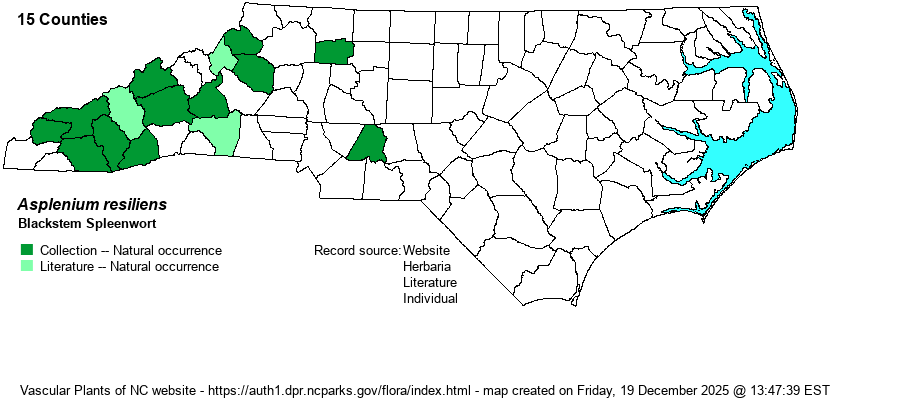| Author | Kunze | |
| Distribution | Present over most of the Mountains and at a very few places in the western and central Piedmont, where mostly of historical occurrence. Specimens from the eastern Coastal Plain are believed to refer to the very similar A. heteroresiliens and are excluded from the map below. Weakley's (2018) map does not show its presence in the NC Coastal Plain.
This is a Southern species found mostly in montane regions -- Appalachians, Ozarks, etc. It ranges from southern PA and NV south to northern FL and AZ, and through tropical America.
| |
| Abundance | Rare to very uncommon in the Mountains, and very rare in the adjacent Piedmont foothills. This is a Watch List species. | |
| Habitat | This species is a rock-requisite species, grows almost strictly on calcareous rocks (limestone), but occasionally on other rocks where there are some calcareous minerals in otherwise felsic or mafic rock material. It grows in rock crevices, both in dry/exposed sites and in more moist and shaded rock faces. | |
| Phenology | Fruits from April to October. | |
| Identification | This species and the Coastal Plain A. heteroresiliens are quite similar, as the scientific names might suggest. This species has several fronds in a clump, each with a shining dark brown stipe about 2-3 inches long, topped by a very narrowly oblong blade about 6-9 inches long but barely 1 inch wide. The 14-30 pairs of pinnae are strictly opposite, even to the apex -- with only pinnate lobing. Each pinna is oblong and about 2/5-inch long and 1/6-inch wide, with a rounded tip and with a single lobe at the base but otherwise the margins are barely serrate (and essentially look entire). The pinnae are evergreen, coriaceous, thick and blue-green in color. The sori are on the blade undersides, diagonally along the midline of each pinna. A. heteroresiliens has pinnae with somewhat more obvious small teeth, blades thin and bright green, and with the middle and upper pinnae alternate as opposed to opposite in A. resiliens. A. monanthes has generally just a single (to rarely 3) sori under a given pinna, as opposed to 4-10 in other species. The very common and widespread A. platyneuron has more obvious basal lobes on the pinnae and most pinnae are alternate; the pinnae are longer, and the species usually does not grow on limestone rocks. A. trichomanes has pinnae very small and almost rounded, with no basal lobes. | |
| Taxonomic Comments | None
| |
| Other Common Name(s) | None | |
| State Rank | S2 | |
| Global Rank | G5 | |
| State Status | W1 | |
| US Status | | |
| USACE-agcp | | |
| USACE-emp | | |

